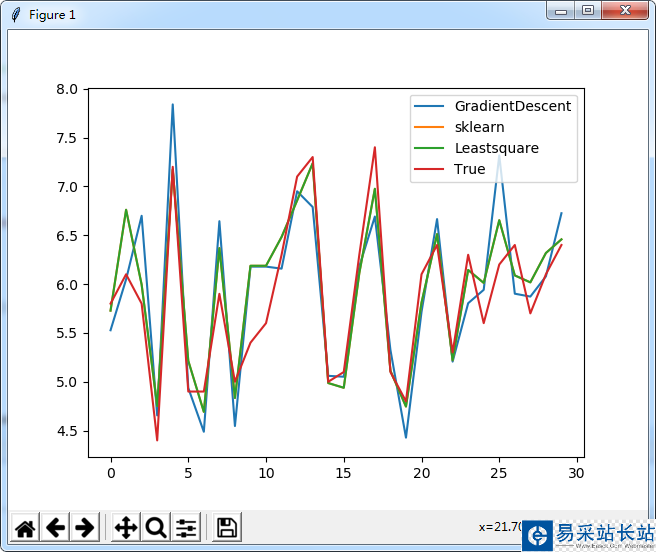本文實例講述了Python實現的線性回歸算法。分享給大家供大家參考,具體如下:
用python實現線性回歸
Using Python to Implement Line Regression Algorithm
小菜鳥記錄學習過程
代碼:
#encoding:utf-8""" Author: njulpy Version: 1.0 Data: 2018/04/09 Project: Using Python to Implement LineRegression Algorithm"""import numpy as npimport pandas as pdfrom numpy.linalg import invfrom numpy import dotfrom sklearn.model_selection import train_test_splitimport matplotlib.pyplot as pltfrom sklearn import linear_model# 最小二乘法def lms(x_train,y_train,x_test): theta_n = dot(dot(inv(dot(x_train.T, x_train)), x_train.T), y_train) # theta = (X'X)^(-1)X'Y #print(theta_n) y_pre = dot(x_test,theta_n) mse = np.average((y_test-y_pre)**2) #print(len(y_pre)) #print(mse) return theta_n,y_pre,mse#梯度下降算法def train(x_train, y_train, num, alpha,m, n): beta = np.ones(n) for i in range(num): h = np.dot(x_train, beta) # 計算預測值 error = h - y_train.T # 計算預測值與訓練集的差值 delt = 2*alpha * np.dot(error, x_train)/m # 計算參數的梯度變化值 beta = beta - delt #print('error', error) return betaif __name__ == "__main__": iris = pd.read_csv('iris.csv') iris['Bias'] = float(1) x = iris[['Sepal.Width', 'Petal.Length', 'Petal.Width', 'Bias']] y = iris['Sepal.Length'] x_train, x_test, y_train, y_test = train_test_split(x, y, test_size=0.2, random_state=5) t = np.arange(len(x_test)) m, n = np.shape(x_train) # Leastsquare theta_n, y_pre, mse = lms(x_train, y_train, x_test) # plt.plot(t, y_test, label='Test') # plt.plot(t, y_pre, label='Predict') # plt.show() # GradientDescent beta = train(x_train, y_train, 1000, 0.001, m, n) y_predict = np.dot(x_test, beta.T) # plt.plot(t, y_predict) # plt.plot(t, y_test) # plt.show() # sklearn regr = linear_model.LinearRegression() regr.fit(x_train, y_train) y_p = regr.predict(x_test) print(regr.coef_,theta_n,beta) l1,=plt.plot(t, y_predict) l2,=plt.plot(t, y_p) l3,=plt.plot(t, y_pre) l4,=plt.plot(t, y_test) plt.legend(handles=[l1, l2,l3,l4 ], labels=['GradientDescent', 'sklearn','Leastsquare','True'], loc='best') plt.show()輸出結果

sklearn: [ 0.65368836 0.70955523 -0.54193454 0. ]
LeastSquare: [ 0.65368836 0.70955523 -0.54193454 1.84603897]
GradientDescent: [ 0.98359285 0.29325906 0.60084232 1.006859 ]
附:上述示例中的iris.csv文件點擊此處本站下載。
更多關于Python相關內容感興趣的讀者可查看本站專題:《Python數學運算技巧總結》、《Python數據結構與算法教程》、《Python函數使用技巧總結》、《Python字符串操作技巧匯總》及《Python入門與進階經典教程》
新聞熱點
疑難解答